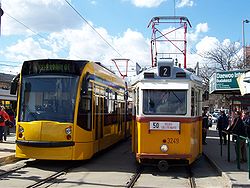- Combino Supra
-
The Combino Supra (
 /ˈsuːprə/), Combino MkII, or Combino Plus is a new Combino model made of stainless steel instead of light materials, and manufactured at a new assembly line in Vienna.
/ˈsuːprə/), Combino MkII, or Combino Plus is a new Combino model made of stainless steel instead of light materials, and manufactured at a new assembly line in Vienna.Contents
Design differences with original Combino
Unlike the former Combino model, the Combino Supra is designed in nine meter fixed sections. Each section has a bogie, either powered or unpowered. The tram length can be anywhere from two sections (18 meters) to eight (72 meters). In the Budapest and Almada trams, modules are placed in two car blocks, each block joined by a double articulation join. This is in contrast to the original Combino, and other articulated low floor trams, where modules are suspended between others. Siemens claims the axle load of this design is 10 metric tonnes for a tram width of 2.65 meters, such as the Almada tram.[1]
For the Budapest order, the tram went from nine modules of the original Combino to six modules for the Combino Supra.[2]
The original Combino design featured a half-width door near the drivers cab. The Combino Supra has changed this to a full double-leaf door.
Budapest
The city transport company of Budapest has ordered 40 Combino Supra Budapest NF 12B units. The six-module trams (three units of two carbody sections) are 53.99 meters long, a world record for passenger trams (only exceeded by the 59.4 m CarGoTram of Dresden). They have been nicknamed óriáshernyó (meaning 'giant caterpillar'). The first two units were delivered March 14, 2006 to Budapest, the rest was delivered by the summer of 2007.
In the summer of 2006 problems arose with the Budapest version of the Combino. On August 1, 2006 Budapest mayor Gábor Demszky ordered all six Combino trams to be withdrawn from service until technical problems that arose in the previous months were cleared up.[3] There were problems with the doors, caused by sensitive fail-safe systems which brought trams to a halt for reasons including luggage or the odd leg getting stuck in a door.[4] Siemens AG reportedly admitted the door problem to be a "design fault".[5]
Another problem was the overhead wire system of the track, which was rebuilt in April and June to accommodate the new trams. The rebuilding was done in a hurry and of poor quality, causing the old Ganz trams still running on the track to have problems with their pantographs. On July 15 one column of the overhead wire system fell to the road on the Margaret Bridge, causing tram services to be suspended between Jászai Mari tér and Moszkva tér till July 25.[6] In the last week of August the wire system was adjusted to prevent new problems from occurring.[7]
The teething problems were eventually sorted out, and all 40 trams were in regular service by the summer of 2007. But Siemens realises further improvements in the ventilation (the vehicles were ordered without air conditioning), and door closing signals will be changed, after inhabitants of the streets passed complained that they are too loud by night.
Almada, Lisbon
The transport company Metro Transportes Sul de Tejo (MST) ordered 24 four-module Combinos for the new tram network Metro sul do Tejo in Almada, South of Lisbon. Although the first unit was delivered by the end of May 2005, after the problems with the Combino surfaced, the order was converted to stainless steel-bodied Combinos, to be delivered by 2007.
Siemens bought Almada tram C008 to Melbourne, Australia to run in passenger service on Melbourne's tram network, for research and development purposes.[8] However, some commentators believed it was motivated by the potential for an upcoming tram order. C008 ran on Route 16, alongside the classic Combino, and other tram models. C008 first entered Melbourne service on Grand Prix shuttles on Route 96 in March, and ran on Route 16 thereafter until Saturday, 16 June.
See also
References
- ^ Siemens Combino Plus website - 'Flexibility'
- ^ Combino Budapest Reference brochure
- ^ Caboodle.hu - Budapest mayor calls for withdrawal of faulty Combino trams
- ^ The Budapest Sun Online - Mayor touts Budapest as leading regional capital
- ^ Caboodle.hu - New Combino tram fails shortly after resuming service
- ^ Railway Market Magazine - Public Transport in Hungary: Combino-Teething Troubles in Budapest
- ^ Caboodle.hu - Tram service suspended every evening until September
- ^ - Siemens Transportation Australia Combino Plus
External links
Categories:- Passenger rail vehicles
- Light rail vehicles
- Tram vehicles of Hungary
- Melbourne tram vehicles
- Tram vehicles of Portugal
- Siemens products
Wikimedia Foundation. 2010.


